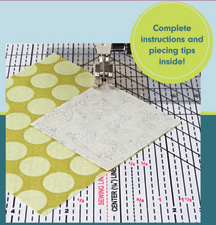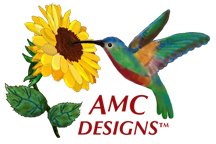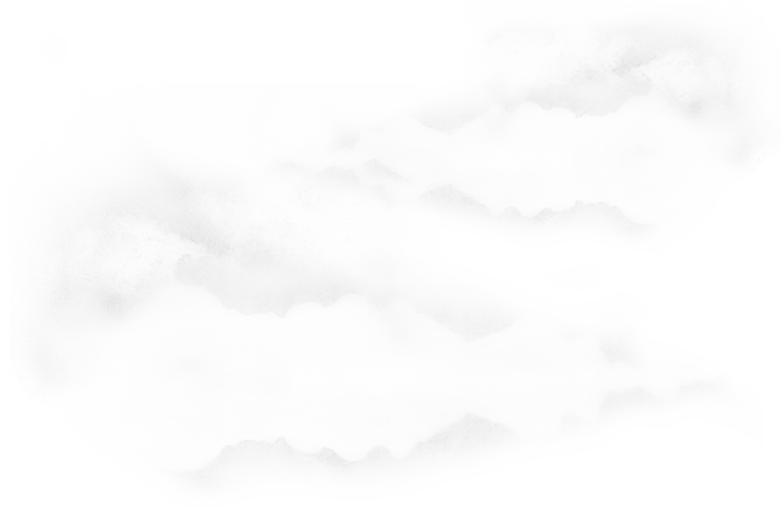

for quilters, sewers, crafters, and decorators
Ultimate Seam Guide
About Annis
Quilts have been a part of Annis Clapp’s life since she was a child. Her mother, both of her grandmothers, and many other relatives made quilts at some point during their lives. The quilts she remembers most were those made by her paternal grandmother who was a prolific quilter.
Although Annis didn’t start quilting until she was older and had a home of her own, her love of sewing and other needlecrafts started at a young age. Like many, she learned to sew by hand sewing doll clothes, often designing her own patterns or modifying existing ones. She received her first income from sewing while still in high school, sewing for teachers and a classmate. After 10 years of mostly sewing clothes, her interests changed to home decorating. She designed and made many quilts for her family throughout the mid ‘70s and ‘80s before changing to smaller gift items and turning her love of sewing into a part-time career as a work-at-home mom while raising 3 children.
In the late ‘90s while making her youngest son’s wedding quilt, she became interested in quick-piecing techniques. She started collecting quilt books and studying all of the different ways there were to piece blocks. Then in 2001 she discovered rag quilting, and for the next several years she designed many quilts using this technique and had 3 rag quilting books published by Leisure Arts.
Her desire for speed and accuracy in her quilting skills led to the development of a seam guide for the sewing machine in 2003. Her math and drafting skills have made it possible for her to develop or modify many piecing techniques and she has designed and pieced many quilts using these techniques over the past decade.
She is mostly a self-taught quilter and wasn’t aware that you were supposed to take classes. After joining the local quilt guild in 2003 she has signed up for an occasional workshop with international quilters. She still finds herself rewriting the instructions and finishing the projects using her own techniques.
Many of her patterns and tools were inspired by those who have shared their designs, ideas, and techniques over the years. Her goal is to be an inspiration to others as well.
When she isn’t sewing or doing anything quilt related, she enjoys reading and spending time with her 11 grandchildren and many other family members and friends. She also works part-time as a bookkeeper and does occasional drafting for the family construction business.
Quilts have been a part of Annis Clapp’s life since she was a child. Her mother, both of her grandmothers, and many other relatives made quilts at some point during their lives. The quilts she remembers most were those made by her paternal grandmother who was a prolific quilter.
Although Annis didn’t start quilting until she was older and had a home of her own, her love of sewing and other needlecrafts started at a young age. Like many, she learned to sew by hand sewing doll clothes, often designing her own patterns or modifying existing ones. She received her first income from sewing while still in high school, sewing for teachers and a classmate. After 10 years of mostly sewing clothes, her interests changed to home decorating. She designed and made many quilts for her family throughout the mid ‘70s and ‘80s before changing to smaller gift items and turning her love of sewing into a part-time career as a work-at-home mom while raising 3 children.
In the late ‘90s while making her youngest son’s wedding quilt, she became interested in quick-piecing techniques. She started collecting quilt books and studying all of the different ways there were to piece blocks. Then in 2001 she discovered rag quilting, and for the next several years she designed many quilts using this technique and had 3 rag quilting books published by Leisure Arts.
Her desire for speed and accuracy in her quilting skills led to the development of a seam guide for the sewing machine in 2003. Her math and drafting skills have made it possible for her to develop or modify many piecing techniques and she has designed and pieced many quilts using these techniques over the past decade.
She is mostly a self-taught quilter and wasn’t aware that you were supposed to take classes. After joining the local quilt guild in 2003 she has signed up for an occasional workshop with international quilters. She still finds herself rewriting the instructions and finishing the projects using her own techniques.
Many of her patterns and tools were inspired by those who have shared their designs, ideas, and techniques over the years. Her goal is to be an inspiration to others as well.
When she isn’t sewing or doing anything quilt related, she enjoys reading and spending time with her 11 grandchildren and many other family members and friends. She also works part-time as a bookkeeper and does occasional drafting for the family construction business.
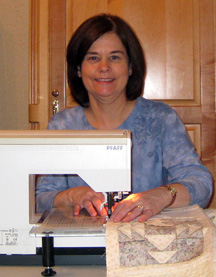
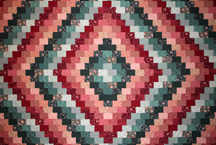
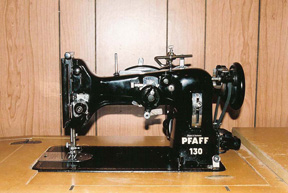
DIAMOND PATCH
80" x 90" – August 2000
This is the quilt that started me on my journey as a professional quilter. It was strip-pieced and quilted in sections. Read more...
80" x 90" – August 2000
This is the quilt that started me on my journey as a professional quilter. It was strip-pieced and quilted in sections. Read more...

This is the sewing machine I taught myself to sew on at age 12. It is set in a cabinet and has a knee pedal instead of a foot pedal for power, as did the first sewing machine I bought for myself at age 18, which was financed by my maternal grandmother who had much faith in my future endeavors and for whom I was named.
Products I Use
These are some of my favorite products or products that I use most often when making quilts.
SEWING MACHINE
Pfaff performance 2054 for piecing – The dual feed is its best feature and works great for my reverse paper piecing technique. I keep it engaged for all piecing, especially when sewing long strips. The 1/4" foot and open toe applique foot are the ones I use the most. I use it with a Sew Steady Portable Table and my Ultimate Seam Guide.
Janome 6600 for quilting – The open toe walking foot, wider space for maneuvering the quilt, and the fact that it sews invisible thread without breaking or skipping stitches makes this machine work for me.
THREAD
I use a variety of threads, but lately have been using Guterman and Aurifil 100% cotton for piecing because they are finer threads and the bobbin holds more and lasts longer, and I never have a problem with breakage. When I need matching thread I use Mettler 100% cotton silk finish thread. YLI multi-colored 100% cotton thread for machine quilting is another favorite.
FOUNDATION PAPER
My overall favorite is a translucent vellum paper from Office Depot. It is see-thru, absorbs the ink, doesn’t shrink, prints in ink jet printers with no paper jams, and tears away easily after stitching. It comes in a 50 sheet pad of 81/2" x 11" or 11" x17" sheets. I use a paper cutter to cut the larger sheets in half for printing. If you search for it on their website you will find it under tracing paper.
RULERS
I have too many rulers to list, but the ones I’ve used the most over the years are the Omnigrid-Omnigrip series because they have dots at the 1/4" marks and work best for squaring up blocks. I’m beginning to not like the yellow lines though as my vision is changing and they block my view. The frosted Olfa are my current favorite for cutting strips and I use the 11/4" x 121/2" size on a regular basis for trimming seams for my reverse paper piecing technique. Other favorites are specialty rulers that are clear with black lines and June Tailor has a series of square-up rulers that work for squaring up the pineapple blocks in my Pineapple Split pattern.
CUTTING TOOLS
Rotary Cutter – The 45mm Olfa Ergonomic Rotary Cutter is the one I use the most. The 60mm is good for cutting multiple layers of fabric.
Mat – I’m currently using a green Omnigrid self healing mat. When I need a lighter color for better vision I use a Fiskar’s yellow and pink mat. I also have an Olfa turn table that I use occasionally and a smaller Olfa mat for classes and retreats.
SEAM GUIDE
The Ultimate Seam Guide that I designed is my favorite. I keep it on my machine at all times for all of my sewing, only removing it for cleaning. After using it since 2003, it has become a part of my machine and it wouldn’t be “dressed” without it.
Sewing Edge by Alicia’s Attic – I place this to the right of my seam guide to make it easy to reposition it. Sometimes I use it on my seam guide for odd size seams or if for some reason I need to reposition the needle and the lines on the seam guide no longer work.
Scrapbooking Tape – I’ve found this to be the best tape for taping the seam guide to the sewing surface without leaving a sticky residue. Blue Painter’s Tape would also work but isn’t very pretty.
Scotch Poster Tape and 3/4" Peel n Stick Double Sided Adhesive Tape – This is for replacing the tape on my seam guide bars when they no longer stick.
FABRIC
I use all types of good quality 100% cotton fabrics.
NOTIONS, ETC.
Magnetic Pin Holder
Extra Fine Glass Head Pins
Schmetz Quilting Needles
OESD Embroidery Needles
Quilter’s Safety Pins
Seam Ripper
Sewing Gauge
Steel Retractable Tape Measure
Fiskar’s Softgrip Scissors
Westcott Titanium Scissors
General’s Chalk Marker
Water Soluble Marker
Glue Stick
Freezer Paper
Masking Tape
Golden Threads Quilting Paper
Soft Fuse Paper-Backed Fusible Web
Quilter’s Grid
Mountain Mist Cream Rose Batting
Ott-Lite
Extra Wide Ironing Board
Steam Iron
Lint Roller
0.7 Pentel Mechanical Pencil for Drafting
Bostitch Stapler (at least 30 years old)
Staple Remover
Notepad
Calculator
P-Touch Labeling System
Stackable Clear Plastic Drawers and Bins for Storage
These are some of my favorite products or products that I use most often when making quilts.
SEWING MACHINE
Pfaff performance 2054 for piecing – The dual feed is its best feature and works great for my reverse paper piecing technique. I keep it engaged for all piecing, especially when sewing long strips. The 1/4" foot and open toe applique foot are the ones I use the most. I use it with a Sew Steady Portable Table and my Ultimate Seam Guide.
Janome 6600 for quilting – The open toe walking foot, wider space for maneuvering the quilt, and the fact that it sews invisible thread without breaking or skipping stitches makes this machine work for me.
THREAD
I use a variety of threads, but lately have been using Guterman and Aurifil 100% cotton for piecing because they are finer threads and the bobbin holds more and lasts longer, and I never have a problem with breakage. When I need matching thread I use Mettler 100% cotton silk finish thread. YLI multi-colored 100% cotton thread for machine quilting is another favorite.
FOUNDATION PAPER
My overall favorite is a translucent vellum paper from Office Depot. It is see-thru, absorbs the ink, doesn’t shrink, prints in ink jet printers with no paper jams, and tears away easily after stitching. It comes in a 50 sheet pad of 81/2" x 11" or 11" x17" sheets. I use a paper cutter to cut the larger sheets in half for printing. If you search for it on their website you will find it under tracing paper.
RULERS
I have too many rulers to list, but the ones I’ve used the most over the years are the Omnigrid-Omnigrip series because they have dots at the 1/4" marks and work best for squaring up blocks. I’m beginning to not like the yellow lines though as my vision is changing and they block my view. The frosted Olfa are my current favorite for cutting strips and I use the 11/4" x 121/2" size on a regular basis for trimming seams for my reverse paper piecing technique. Other favorites are specialty rulers that are clear with black lines and June Tailor has a series of square-up rulers that work for squaring up the pineapple blocks in my Pineapple Split pattern.
CUTTING TOOLS
Rotary Cutter – The 45mm Olfa Ergonomic Rotary Cutter is the one I use the most. The 60mm is good for cutting multiple layers of fabric.
Mat – I’m currently using a green Omnigrid self healing mat. When I need a lighter color for better vision I use a Fiskar’s yellow and pink mat. I also have an Olfa turn table that I use occasionally and a smaller Olfa mat for classes and retreats.
SEAM GUIDE
The Ultimate Seam Guide that I designed is my favorite. I keep it on my machine at all times for all of my sewing, only removing it for cleaning. After using it since 2003, it has become a part of my machine and it wouldn’t be “dressed” without it.
Sewing Edge by Alicia’s Attic – I place this to the right of my seam guide to make it easy to reposition it. Sometimes I use it on my seam guide for odd size seams or if for some reason I need to reposition the needle and the lines on the seam guide no longer work.
Scrapbooking Tape – I’ve found this to be the best tape for taping the seam guide to the sewing surface without leaving a sticky residue. Blue Painter’s Tape would also work but isn’t very pretty.
Scotch Poster Tape and 3/4" Peel n Stick Double Sided Adhesive Tape – This is for replacing the tape on my seam guide bars when they no longer stick.
FABRIC
I use all types of good quality 100% cotton fabrics.
NOTIONS, ETC.
Magnetic Pin Holder
Extra Fine Glass Head Pins
Schmetz Quilting Needles
OESD Embroidery Needles
Quilter’s Safety Pins
Seam Ripper
Sewing Gauge
Steel Retractable Tape Measure
Fiskar’s Softgrip Scissors
Westcott Titanium Scissors
General’s Chalk Marker
Water Soluble Marker
Glue Stick
Freezer Paper
Masking Tape
Golden Threads Quilting Paper
Soft Fuse Paper-Backed Fusible Web
Quilter’s Grid
Mountain Mist Cream Rose Batting
Ott-Lite
Extra Wide Ironing Board
Steam Iron
Lint Roller
0.7 Pentel Mechanical Pencil for Drafting
Bostitch Stapler (at least 30 years old)
Staple Remover
Notepad
Calculator
P-Touch Labeling System
Stackable Clear Plastic Drawers and Bins for Storage
